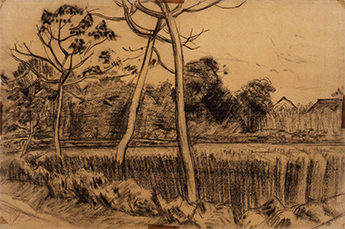Curators’ selection — Hidden Masterpieces
KAWAKAMI Ryoka, Early Summer, 1919, Oil on canvas
KAWAKAMI Ryoka, Early Summer, 1919, Oil on canvas
Behind a slender, tall tree, a simplified pastoral landscape fills the background. The Japanese title of this work, Bakushu, which is translated Early Summer, refers to the season when barley is harvested. The lower portion of the painting is filled with the ripening colors of a barley field; the people harvesting the crop are rendered on quite small scale. The golden barley field and partially golden sky generate beautiful contrasts with the rich green hues of early summer and the blue sky.
Kawakami Ryoka (1887-1921) was, with Kishida Ryusei (1891-1929), a central figure in the Fusain-kai, a group of young artists active in Tokyo in the Taisho period. Ryoka died, however, of tuberculosis at the young age of 34, and almost all his work was destroyed by fire during the war. Thus, his name is almost unknown today. Early Summer was donated to the Artizon Museum by Sakai Okuhiro (1894-1983), a friend of Ryoka, who was an entrepreneur and art collector. According to Sakai, Ryoka, who was known as the “Nakano hermit,” lived an extremely serious, modest life, a life with the quietness of a stream that flows without making a sound. After establishing his atelier in Higashi Nakano, Tokyo, he created many charcoal drawings of the surrounding landscape (fig. 1). While it was his financial circumstances that initially led him to work in charcoal, Ryoka’s intense study of depicting nature and expressing life in a world without color led to his developing a new style. Early Summer is one of his rare oil paintings from that period.
In this painting, Ryoka used the broken brushstrokes technique, painting with repeated, layered short brushstrokes. The same technique can be seen in his Railroad (1912, The National Museum of Modern Art, Tokyo), which is regarded as being in the manner of van Gogh. Railroad, the colors are overlapped in complex way so that they seem to be mingled. By contrast, in Early Summer he has addressed his subject more abstractly, and the motion of his brush is more restrained. Thus, rather than resembling van Gogh’s style, this painting suggests the influence of early Fauvist paintings, with their use of bright colors and bold, unmodified brushstrokes, or of Cézanne’s simplification of nature in his paintings.
Ryoka is said to have been fascinated by Cézanne above all near the end of his life. Sadly, when the first public exhibition in Japan of oil paintings by Cézanne was held in 1921, Ryoka was confined to his sickbed and could not realize his dream of seeing an actual work by Cézanne with his own eyes. A painting by Cézanne in our collection, Self-Portrait with a Hat (fig. 2), was shown in that exhibition, having been brought to Japan through the devoted efforts of Mushanokoji Saneatsu and other members of the coterie who published the magazine Shirakaba (White Birch), a leading monthly on literature and the arts. Self-Portrait with a Hat was shown at the first Shirakaba Art Museum Exhibition, which, in a remarkable coincidence, was held in what is now Kyobashi, Tokyo, the home of the Artizon Museum.

- fig.1
- KAWAKAMI Ryoka, Paulownias and Wheats, 1917, Charcoal on paper

- fig.2
- Paul CEZANNE, Self-Portrait with a Hat, c.1890-94, Oil on canvas
-
Emile GALLE, Vase, decorated with dragonfly and flower design, c. 1880-1900
-
NAKAMURA Hochu, Flowers and Plants of the Four Seasons, Edo period, Early 19th century, Color on paper
-
AOKI Shigeru, Face, 1903-04, Colored pencil and wash on paper